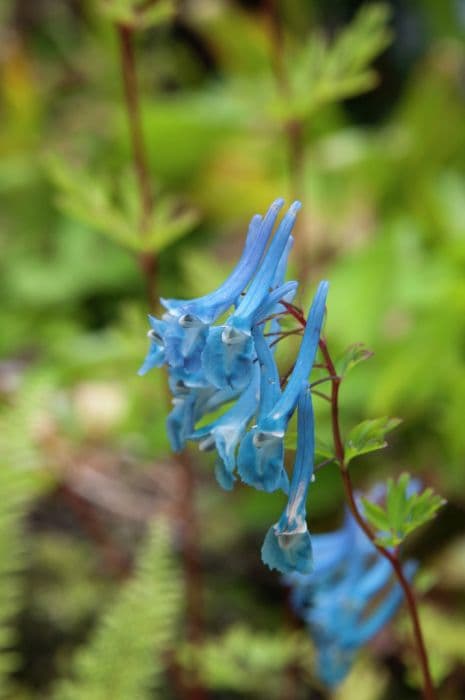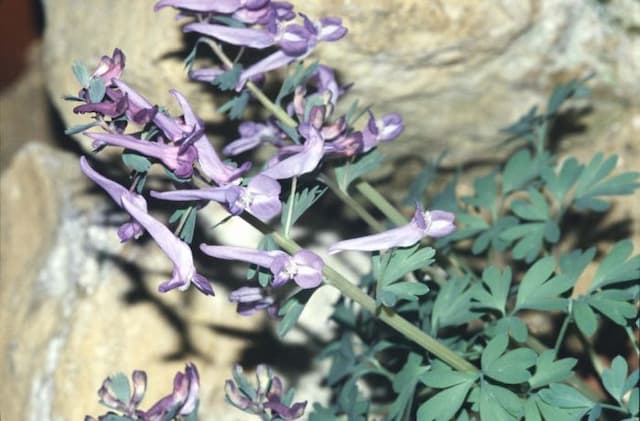Himalayan Blue Poppy Meconopsis (Fertile Blue Group) 'Lingholm'

ABOUT
The Meconopsis 'Lingholm', commonly known as the Himalayan Blue Poppy, is a captivating plant with a striking appearance. It is cherished for its large, showy flowers that boast an intense sky-blue to purplish-blue color. Each blossom presents with delicate, satiny petals that form a cup-shaped flower, creating a soothing and almost ethereal effect. The center of the flower features a cluster of golden-yellow stamens that provide a beautiful contrast to the blue petals. The foliage of the Himalayan Blue Poppy is a fresh, lush green, and the leaves are hairy, which gives them a slightly rough texture to the touch. They form a rosette at the base of the plant with leaves that are intricately lobed, adding a sense of depth and complexity to the plant's overall form. This rosette of leaves serves to further highlight the beauty of the blooms that rise above. The overall impression of the Himalayan Blue Poppy is one of a plant that can bring a unique and exotic splash of color to any garden, with a bloom that could be easily described as otherworldly.
About this plant
 Names
NamesFamily
Papaveraceae.
Synonyms
Lingholm Fertile Blue Group, Fertile Blue Poppy, Lingholm Blue Poppy, Himalayan Blue Poppy.
Common names
Meconopsis 'Lingholm', Meconopsis x sheldonii 'Lingholm'.
 Toxicity
ToxicityTo humans
The Himalayan blue poppy, as Meconopsis (Fertile Blue Group) 'Lingholm' is commonly known, is not generally considered toxic to humans. There is little information on its potential toxicity, but it is mostly grown as an ornamental plant and not for consumption. If ingested, it is unlikely to cause poisoning, but as with any non-food plant, consumption is not advised, and it could cause an upset stomach or an allergic reaction in some individuals.
To pets
The Himalayan blue poppy is not known to be toxic to pets. However, it is not intended for animal consumption, and as with any non-food plant, ingestion may result in gastrointestinal discomfort or an allergic reaction. If you suspect your pet has ingested this plant, monitor for signs of distress and contact your veterinarian if you have concerns.
 Characteristics
CharacteristicsLife cycle
Perennials
Foliage type
Deciduous
Color of leaves
Green
Flower color
Blue
Height
3-4 feet (0.9-1.2 meters)
Spread
1-2 feet (0.3-0.6 meters)
Plant type
Herb
Hardiness zones
5
Native area
Himalayas
Benefits
 General Benefits
General Benefits- Aesthetic Appeal: The Meconopsis 'Lingholm' offers striking blue flowers that can be a focal point in any garden or landscape.
- Habitat Enrichment: This plant provides nectar and pollen for bees and other pollinating insects, supporting local ecosystems.
- Shade Tolerance: It can grow well in partial shade, making it suitable for woodland gardens and shadier spots.
- Cultural Significance: Known commonly as Blue Poppy, it holds a special place in horticulture and often symbolizes the quest for rare and beautiful flora.
- Garden Variation: Adds unique texture and form with its rosette of leaves and tall flower stalks amid more typical garden plants.
 Medical Properties
Medical PropertiesThis plant is not used for medical purposes.
 Air-purifying Qualities
Air-purifying QualitiesThis plant is not specifically known for air purifying qualities.
 Other Uses
Other Uses- The Meconopsis can be used in botanical art, as they are highly admired for their aesthetic appeal and can be a subject for watercolour paintings or detailed botanical drawings.
- As a collector's plant, it can be a unique addition to alpine and rock gardens, providing a striking blue colour that is uncommon amongst other flowering plants in such environments.
- The petals of Meconopsis can be utilized for natural dye production, imparting a range of blue hues to fabrics and textiles when prepared properly.
- In photography, the intense blue flowers serve as a vibrant subject for macro photography, attracting photographers who specialize in plant and nature images.
- These plants can be featured in garden and landscape design competitions for their rarity and the challenge they represent in cultivation, showcasing the gardener's skill.
- Meconopsis plays a role in education, being used in horticulture and botany programs to teach students about the diverse plant life in the Himalayan region and the care of delicate species.
- They can be given as a unique and prestigious gift to plant enthusiasts, reflecting a gesture of high regard given the rarity and the difficulty involved in growing them successfully.
- In climate research, the growth and health of Meconopsis can provide insight into the effects of global warming, as they require specific and cool climate conditions to thrive.
- Meconopsis can be a theme for cultural events or garden shows that celebrate the flora of the Himalayas, where various species of the genus originate from.
- The bloom can be used in floral arrangements, especially for events that desire a unique and strikingly blue theme, although their short lifespan when cut makes them a choice for short-term display.
Interesting Facts
 Feng Shui
Feng ShuiThe Blue Poppy is not used in Feng Shui practice.
 Zodiac Sign Compitability
Zodiac Sign CompitabilityThe Blue Poppy is not used in astrology practice.
 Plant Symbolism
Plant Symbolism- Peace and Tranquility: The Meconopsis, commonly known as Blue Poppy, has a serene and calming blue hue that often symbolizes peace and encourages a sense of tranquility.
- Solitude: Blue Poppies are known for their elusive and solitary nature, growing in remote, mountainous regions, symbolizing the concept of solitude and the beauty of being alone.
- Imagination: The striking appearance of the Blue Poppy stands out in the plant world and symbolizes the power of imagination and wonder.
- Rarity and Uniqueness: Being a rare and unique flower, the Blue Poppy symbolizes the uniqueness of an individual or situation, highlighting the rarity and preciousness of rare moments or entities.
- Dreams: The Blue Poppy’s dreamy appearance has made it a symbol of dreaming, aspiration, and striving towards goals, despite the challenges one might face.
 Water
WaterHimalayan Blue Poppies prefer consistently moist soil, so it is crucial to water them regularly but with caution to avoid waterlogging. They should be watered once the top inch of soil starts to feel dry, which could be about once or twice a week, depending on the weather conditions and soil drainage. It's best to use a watering can to gently water the plants at soil level with approximately 1 gallon of water per week for an established plant, ensuring even soil moisture without over-saturation.
 Light
LightHimalayan Blue Poppy thrives in a spot that offers part shade, with protection from the intense midday sun. They appreciate bright indirect light or dappled sunlight, usually found under the canopy of deciduous trees or on the north side of a building where they receive morning light and are shielded from the harsh afternoon rays.
 Temperature
TemperatureThe Himalayan Blue Poppy does well in cooler conditions and can tolerate a temperature range from about 50 to 75 degrees Fahrenheit. They can survive brief periods outside this range but prefer consistently cool temperatures to flourish. The ideal temperature is between 60 to 70 degrees Fahrenheit during the day and slightly cooler at night.
 Pruning
PruningPruning Himalayan Blue Poppies involves deadheading spent flowers to encourage further blooming and to maintain a tidy appearance. Prune them after the first flush of blooms by cutting back the flower stems to base. This task is typically performed during the summer months after the plant has finished its main flowering period.
 Cleaning
CleaningAs needed
 Soil
SoilThe Himalayan Blue Poppy 'Lingholm' requires a well-draining soil mix rich in organic matter. The ideal pH should be slightly acidic to neutral, ranging from 6.0 to 7.0. Adding leaf mold and grit can improve drainage and fertility, creating the best soil environment for this plant's growth.
 Repotting
RepottingHimalayan Blue Poppies such as 'Lingholm' do not require frequent repotting and can be repotted every 2-3 years. The repotting should be done with care, as they are sensitive to root disturbance.
 Humidity & Misting
Humidity & MistingHimalayan Blue Poppy 'Lingholm' thrives in high humidity environments, ideally between 50-70%. They benefit from being placed in a naturally moist atmosphere, mimicking their native mountainous habitat.
 Suitable locations
Suitable locationsIndoor
Ensure bright indirect light, cool temps, and high humidity for indoor 'Lingholm'.
Outdoor
Plant in partial shade, moist soil, protect from wind, and mulch in 'Lingholm'.
Hardiness zone
5-7 USDA
 Life cycle
Life cycleThe Meconopsis 'Lingholm', commonly known as the Fertile Blue Poppy, begins its life cycle when a seed germinates in the cool, moist conditions of spring or early summer. A rosette of leaves emerges first, providing energy through photosynthesis as the plant establishes a root system. Over a period of one or more years, the plant grows and stores energy in the roots, preparing for the flowering stage. Once mature, the Meconopsis 'Lingholm' sends up a tall flowering stem that produces large, striking blue flowers, attracting pollinators to aid in reproduction. After pollination, the flowers wilt and the plant produces seed capsules which, when mature, release seeds for dispersal. The parent plant typically dies after seeding, having completed its perennial cycle, though some may survive to flower again in subsequent years.
 Propogation
PropogationPropogation time
Spring-Early Summer
The Meconopsis, commonly known as the Himalayan blue poppy, is best propagated through seed sowing. The optimal time for propagation is late winter to early spring when ambient temperatures range from cool to mildly warm. To propagate by seed, one should use a well-drained soil mix, sprinkling the seeds on the surface and then lightly covering them with a thin layer of soil, no more than an eighth of an inch (about 3 millimeters) deep. The container should then be placed in a cool location with indirect light and kept moist. Germination can be erratic, but gentle warmth beneath the container, like using a propagation mat, can improve success rates. Seedlings should be carefully transplanted to individual pots once they are large enough to handle, and then grown on in cooler conditions until they are ready to plant out after the risk of frost has passed.









